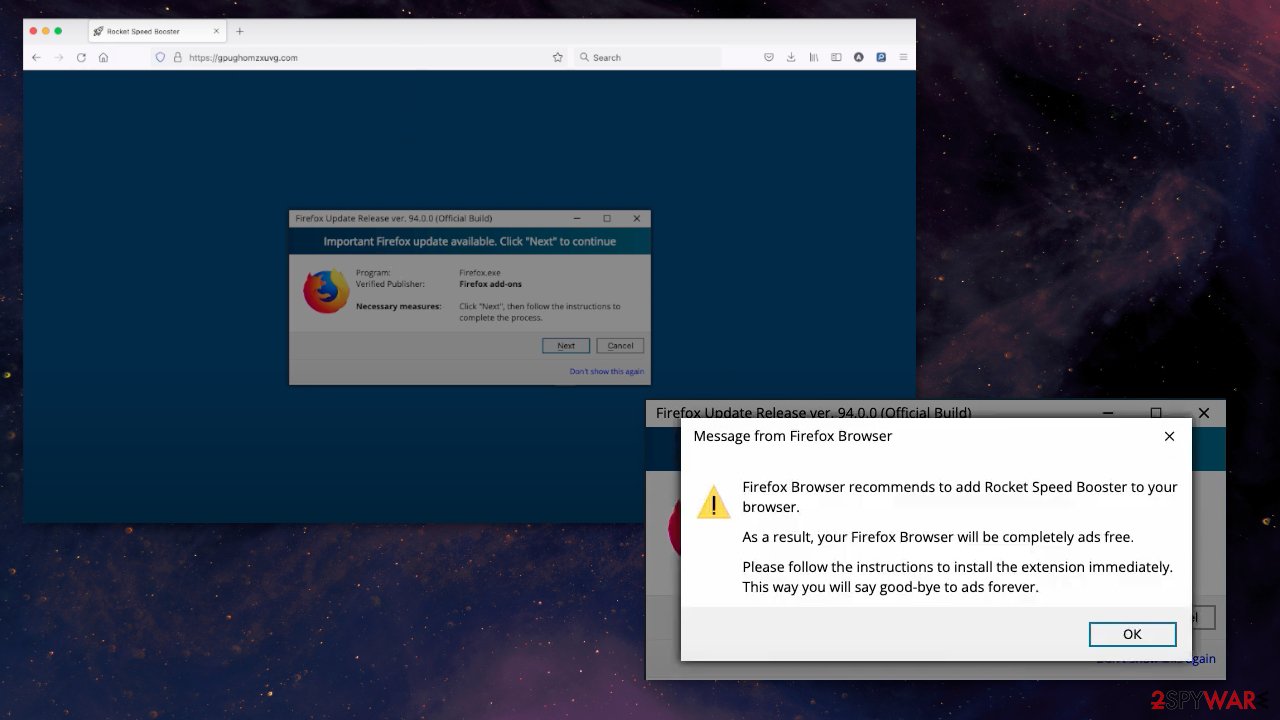Rocket Speed Booster browser hijacker (virus) - Free Instructions
Rocket Speed Booster browser hijacker Removal Guide
What is Rocket Speed Booster browser hijacker?
Rocket Speed Booster by Andre Squires is spread using deceptive techniques

Rocket Speed Booster is a browser hijacker that changes the main settings, like the homepage, new tab address, and search engine. It does this to monetize users' activity by injecting ads in the search results and redirecting them to promotional pages. Ads that start showing up are not always trustworthy and as a result, can lead to monetary losses, installations of other PUPs[1] (potentially unwanted programs), or even malware.
This extension is specifically created to infect people who use Mozilla Firefox as their browser. That the add-on is fake, indicates different promotional selling points on different sources. On one page it says “Tired of websites loading slowly? Time to update them!” and on the other one, it says that you will be able to enjoy ad-free browsing. These are two completely different functions.
| NAME | Rocket Speed Booster |
| TYPE | Browser hijacker; potentially unwanted program |
| SYMPTOMS | The main browser settings get changed, like the homepage, new tab address, and search engine; ads appear where they should not |
| DISTRIBUTION | Fake Firefox update alerts |
| DANGERS | The application can lead to dangerous sites where users can be tricked into providing their personal information |
| ELIMINATION | Go to your browser settings to remove the plugin |
| FURTHER STEPS | Use a repair tool like FortectIntego to fix any remaining damage |
Usually, legitimate extensions have only one ability that they try to perfect. This could be providing users with automatic ad and dangerous page blocking or the best coupon code application while shopping online. If you see many claims, this should raise a red flag immediately.
Browser hijackers belong to the PUA category and it is a growing problem on the Internet. The first issue is that it is hard for web stores to decide what is an unwanted application. One user could find the program useful in some ways, and the other one might think that it is a virus. That is why users sometimes infect themselves with hijackers even from official web stores.
Distribution techniques
The hijacker is promoted by fake Firefox update alerts. A separate website – gpughomzxuvg.com is used to spread the add-on. A prompt is shown on the page which says that an “Important Firefox update” is available. Shortly after that, a second prompt appears as a “Message from Firefox Browser”:
Firefox Browser recommends to add Rocket Speed Booster to your browser.
As a result, your Firefox Browser will be completely ads free.
Please follow the instructions to install the extension immediately. This way you will say good-bye to ads forever.
Fake plugins just like this one, often have dedicated websites that are meant to be spread around the Internet to promote it. Usually, they are placed on unregulated websites like illegal streaming platforms[2] that are full of deceptive ads and sneaky redirects. Fake prompts often fool less IT-savvy people that do not know about phishing[3] methods that fraudsters use online.

Sometimes these promotional sites redirect users straight to official web stores, which makes everything look legitimate. But as we mentioned above, hijackers can be found there also. Users have to take matters into their own hands and do their own research. Try to find reviews, ratings, press about the application. See if you can find any information about who developed it. Often, there is not much you can find about these types of applications and that is definitely a thing you should look out for.
Remove the extension that causes advertisements to appear

When you are adding a plugin to your browser, you should pay attention to the prompts. Often, they will give all the information about what the app will do, and what permissions you need to grant it. As you can see in the picture above, before the installation, the prompt says that the extension will have permission to access your data for all websites and access browser tabs.
Another thing you should do is read the Privacy Policy and Terms of Use if they are available because often, these types of applications not only inject ads and generate revenue from pay-per-click advertising,[4] but also by collecting browsing-related data and selling it to advertising networks.
They use cookies to do that, and the good news is that you can delete them anytime. Many users do not know the dangers that cookies[5] could pose and many forget that they exist and never clear them. That is why we recommend getting a tool like FortectIntego to do it for you. The next thing you need to do is go to your browser settings, disable and remove the unwanted extension:
- Open Mozilla Firefox browser and click on the Menu (three horizontal lines at the top-right of the window).
- Select Add-ons.
- In here, select unwanted plugin and click Remove.
![Remove extensions from Firefox Remove extensions from Firefox]()
Reset the homepage:
- Click three horizontal lines at the top right corner to open the menu.
- Choose Options.
- Under Home options, enter your preferred site that will open every time you newly open the Mozilla Firefox.
Clear cookies and site data:
- Click Menu and pick Options.
- Go to Privacy & Security section.
- Scroll down to locate Cookies and Site Data.
- Click on Clear Data…
- Select Cookies and Site Data, as well as Cached Web Content and press Clear.
![Clear cookies and site data from Firefox Clear cookies and site data from Firefox]()
Reset Mozilla Firefox
If clearing the browser as explained above did not help, reset Mozilla Firefox:
- Open Mozilla Firefox browser and click the Menu.
- Go to Help and then choose Troubleshooting Information.
![Reset Firefox 1 Reset Firefox 1]()
- Under Give Firefox a tune up section, click on Refresh Firefox…
- Once the pop-up shows up, confirm the action by pressing on Refresh Firefox.
Scan your system to find PUAs
If the previous removal method did not work, you most likely have a potentially unwanted program operating in your system and it is not simply an extension problem. In that case, simply removing it and changing your settings back, will not work. They will get reverted again until you completely eliminate the intruder operating in the background.
Manual removal of a PUA can get a little complicated if the program is not named the same. You might delete the wrong apps if you attempt to do this on your own. SpyHunter 5Combo Cleaner or Malwarebytes are great professional security tools that can automatically scan your machine for suspicious processes, and eliminate them completely with all the related files. If you still want to do this yourself, you can follow the step-by-step instructions for Windows and Mac operating systems below:
Windows 10/8:
- Enter Control Panel into Windows search box and hit Enter or click on the search result.
- Under Programs, select Uninstall a program.
![Uninstall from Windows 1 Uninstall from Windows 1]()
- From the list, find the entry of the suspicious program.
- Right-click on the application and select Uninstall.
- If User Account Control shows up, click Yes.
- Wait till uninstallation process is complete and click OK.
![Uninstall from Windows 2 Uninstall from Windows 2]()
Windows 7/XP:
- Click on Windows Start > Control Panel located on the right pane (if you are Windows XP user, click on Add/Remove Programs).
- In Control Panel, select Programs > Uninstall a program.
![Uninstall from Windows 7/XP Uninstall from Windows 7/XP]()
- Pick the unwanted application by clicking on it once.
- At the top, click Uninstall/Change.
- In the confirmation prompt, pick Yes.
- Click OK once the removal process is finished.
Mac:
- From the menu bar, select Go > Applications.
- In the Applications folder, look for all related entries.
- Click on the app and drag it to Trash (or right-click and pick Move to Trash)
![Uninstall from Mac 1 Uninstall from Mac 1]()
To fully remove an unwanted app, you need to access Application Support, LaunchAgents, and LaunchDaemons folders and delete relevant files:
- Select Go > Go to Folder.
- Enter /Library/Application Support and click Go or press Enter.
- In the Application Support folder, look for any dubious entries and then delete them.
- Now enter /Library/LaunchAgents and /Library/LaunchDaemons folders the same way and terminate all the related .plist files.
![Uninstall from Mac 2 Uninstall from Mac 2]()
You may remove virus damage with a help of FortectIntego. SpyHunter 5Combo Cleaner and Malwarebytes are recommended to detect potentially unwanted programs and viruses with all their files and registry entries that are related to them.
Getting rid of Rocket Speed Booster browser hijacker. Follow these steps
Remove from Microsoft Edge
Delete unwanted extensions from MS Edge:
- Select Menu (three horizontal dots at the top-right of the browser window) and pick Extensions.
- From the list, pick the extension and click on the Gear icon.
- Click on Uninstall at the bottom.

Clear cookies and other browser data:
- Click on the Menu (three horizontal dots at the top-right of the browser window) and select Privacy & security.
- Under Clear browsing data, pick Choose what to clear.
- Select everything (apart from passwords, although you might want to include Media licenses as well, if applicable) and click on Clear.

Restore new tab and homepage settings:
- Click the menu icon and choose Settings.
- Then find On startup section.
- Click Disable if you found any suspicious domain.
Reset MS Edge if the above steps did not work:
- Press on Ctrl + Shift + Esc to open Task Manager.
- Click on More details arrow at the bottom of the window.
- Select Details tab.
- Now scroll down and locate every entry with Microsoft Edge name in it. Right-click on each of them and select End Task to stop MS Edge from running.

If this solution failed to help you, you need to use an advanced Edge reset method. Note that you need to backup your data before proceeding.
- Find the following folder on your computer: C:\\Users\\%username%\\AppData\\Local\\Packages\\Microsoft.MicrosoftEdge_8wekyb3d8bbwe.
- Press Ctrl + A on your keyboard to select all folders.
- Right-click on them and pick Delete

- Now right-click on the Start button and pick Windows PowerShell (Admin).
- When the new window opens, copy and paste the following command, and then press Enter:
Get-AppXPackage -AllUsers -Name Microsoft.MicrosoftEdge | Foreach {Add-AppxPackage -DisableDevelopmentMode -Register “$($_.InstallLocation)\\AppXManifest.xml” -Verbose

Instructions for Chromium-based Edge
Delete extensions from MS Edge (Chromium):
- Open Edge and click select Settings > Extensions.
- Delete unwanted extensions by clicking Remove.

Clear cache and site data:
- Click on Menu and go to Settings.
- Select Privacy, search and services.
- Under Clear browsing data, pick Choose what to clear.
- Under Time range, pick All time.
- Select Clear now.

Reset Chromium-based MS Edge:
- Click on Menu and select Settings.
- On the left side, pick Reset settings.
- Select Restore settings to their default values.
- Confirm with Reset.

Remove from Google Chrome
Delete malicious extensions from Google Chrome:
- Open Google Chrome, click on the Menu (three vertical dots at the top-right corner) and select More tools > Extensions.
- In the newly opened window, you will see all the installed extensions. Uninstall all the suspicious plugins that might be related to the unwanted program by clicking Remove.

Clear cache and web data from Chrome:
- Click on Menu and pick Settings.
- Under Privacy and security, select Clear browsing data.
- Select Browsing history, Cookies and other site data, as well as Cached images and files.
- Click Clear data.

Change your homepage:
- Click menu and choose Settings.
- Look for a suspicious site in the On startup section.
- Click on Open a specific or set of pages and click on three dots to find the Remove option.
Reset Google Chrome:
If the previous methods did not help you, reset Google Chrome to eliminate all the unwanted components:
- Click on Menu and select Settings.
- In the Settings, scroll down and click Advanced.
- Scroll down and locate Reset and clean up section.
- Now click Restore settings to their original defaults.
- Confirm with Reset settings.

Delete from Safari
Remove unwanted extensions from Safari:
- Click Safari > Preferences…
- In the new window, pick Extensions.
- Select the unwanted extension and select Uninstall.

Clear cookies and other website data from Safari:
- Click Safari > Clear History…
- From the drop-down menu under Clear, pick all history.
- Confirm with Clear History.

Reset Safari if the above-mentioned steps did not help you:
- Click Safari > Preferences…
- Go to Advanced tab.
- Tick the Show Develop menu in menu bar.
- From the menu bar, click Develop, and then select Empty Caches.

After uninstalling this potentially unwanted program (PUP) and fixing each of your web browsers, we recommend you to scan your PC system with a reputable anti-spyware. This will help you to get rid of Rocket Speed Booster browser hijacker registry traces and will also identify related parasites or possible malware infections on your computer. For that you can use our top-rated malware remover: FortectIntego, SpyHunter 5Combo Cleaner or Malwarebytes.
How to prevent from getting browser hijacker
Stream videos without limitations, no matter where you are
There are multiple parties that could find out almost anything about you by checking your online activity. While this is highly unlikely, advertisers and tech companies are constantly tracking you online. The first step to privacy should be a secure browser that focuses on tracker reduction to a minimum.
Even if you employ a secure browser, you will not be able to access websites that are restricted due to local government laws or other reasons. In other words, you may not be able to stream Disney+ or US-based Netflix in some countries. To bypass these restrictions, you can employ a powerful Private Internet Access VPN, which provides dedicated servers for torrenting and streaming, not slowing you down in the process.
Data backups are important – recover your lost files
Ransomware is one of the biggest threats to personal data. Once it is executed on a machine, it launches a sophisticated encryption algorithm that locks all your files, although it does not destroy them. The most common misconception is that anti-malware software can return files to their previous states. This is not true, however, and data remains locked after the malicious payload is deleted.
While regular data backups are the only secure method to recover your files after a ransomware attack, tools such as Data Recovery Pro can also be effective and restore at least some of your lost data.
- ^ Potentially unwanted program. Wikipedia. The Free Encyclopedia.
- ^ Victor Poitevin. Illegal streaming: beware of the backlash. Stormshield. Security Monitoring.
- ^ Josh Fruhlinger. What is phishing? How this cyber attack works and how to prevent it. Csoonline. Security News, Analysis and Research.
- ^ What Is PPC? Learn the Basics of Pay-Per-Click (PPC) Marketing. WordStream. Advertising Solutions.
- ^ What are Cookies?. Kaspersky. Home Security Blog.






















